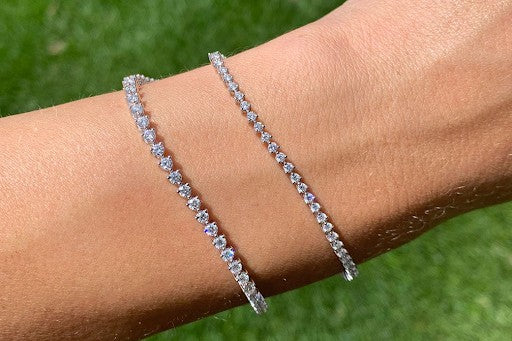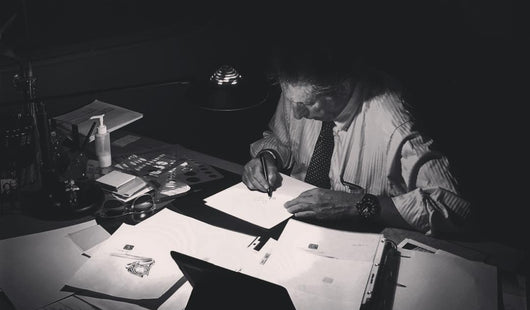Lab vs. Natural Diamond Tennis Bracelets

An iconic jewelry staple, tennis bracelets are sleek and stylish, whether made with lab-grown diamonds or natural diamonds. Here are some of the similarities and differences between lab vs. natural diamond tennis bracelets, along with some tips for choosing a stunning piece for your jewelry collection.
Timeless Elegance and Versatility
Diamond tennis bracelets have long been celebrated for their timeless elegance and versatility. These pieces are not just accessories but symbols of refined style, adaptable for both casual and formal occasions. Their understated yet captivating design makes them a must-have in any jewelry collection.
Whether gracing the wrist during a daytime event or adding a touch of sophistication to an evening ensemble, the diamond tennis bracelet seamlessly transitions across various settings, embodying both luxury and subtlety. You can wear them alone or layer them with any other bracelet or watch to create a personalized look that’s all you.
The decision to choose between lab-grown and natural diamonds adds a layer of personal significance to this timeless piece. Both options offer their own unique advantages, making it essential to consider what matters most to you when selecting your perfect tennis bracelet.
Similarities
Essentially, the difference between lab and natural is both sourcing and long-term value. By selecting lab-grown diamonds, one might express an appreciation for lower costs and modern innovation. On the other hand, choosing natural diamonds might reflect an appreciation for a natural diamond’s higher value and the Earth’s ancient and mystical processes. Whatever the case, when it comes to appearance, both types of diamonds have a lot in common.
Lab-grown diamond tennis bracelets share many similarities with tennis bracelets made with natural diamonds mined from the earth. One of the most compelling things about a lab-grown diamond bracelet is that, to the naked eye, it is absolutely indistinguishable from a tennis bracelet featuring natural diamonds. Even the most knowledgeable diamond detectors aren’t able to identify a lab diamond because they are both optically and chemically identical to natural diamonds.
The only actual variance is that lab diamonds have microscopic laser inscriptions; however, since this is virtually undetectable to the naked eye, no one will ever know whether your diamond tennis bracelet includes naturally mined or lab-grown gemstones. That said, it’s important to remember that lab diamonds don’t retain value as well as natural diamonds, since there are only a limited number of the latter on Earth.
When it comes to quality, both natural and lab-grown diamond tennis bracelets are held to the same strict standards. The 'Four Cs' (cut, color, clarity, and carat weight) have long been used to dictate the value of jewelry-grade diamonds. Lab diamonds are always held to the same unyielding standards as natural diamonds. Whenever you buy a diamond tennis bracelet made with lab diamonds, you can be confident that it will have exceptional-quality gems based on the all-important four Cs.
This consistent evaluation process ensures that whether your diamonds are lab-grown or natural, they will exhibit the same brilliant qualities that define high-quality gemstones. Whether it's the sharp precision of the cut, the purity of the color, the flawless clarity, or the weight of the carat, both lab and natural diamonds are subject to rigorous grading. This attention to detail guarantees that your John Atencio diamond tennis bracelet will maintain its sparkle, radiating the same timeless beauty, regardless of the diamond’s origin.
Differences
One of the biggest differences between natural diamond and lab-grown diamond tennis bracelets centers on sourcing. Since there are a limited number of natural diamonds on the planet, they will always be rarer and more valuable. On the other hand, since lab-grown diamonds are essentially limitless, they don’t tend to be as valuable or expensive as natural diamonds forged over billions of years beneath the surface of the Earth.
The ethical considerations surrounding the sourcing of diamonds are crucial for many buyers. Natural diamonds, while prized for their rarity, can sometimes involve environmental concerns related to mining, including habitat destruction and significant carbon emissions. The mining process can disrupt local ecosystems, leading to long-term environmental degradation and loss of biodiversity. These environmental impacts are a growing concern for ethically-minded consumers who are increasingly aware of the consequences of their purchases.
In contrast, lab-grown diamonds are created in controlled environments that minimize ecological footprints. That said, they do consume a lot of energy during the creation process, and this is something to consider if that particular issue is especially meaningful to you.
Ultimately, ethical concerns aren’t an issue when you shop with an ethical jewelry designer such as John Atencio, who sources his diamonds from reputable long-standing suppliers, who only mine in ethical ways.
That said, not all diamond jewelers embrace John Atencio’s unwavering ethical standards. When creating his uniquely beautiful diamond tennis bracelets, John maintains a strict adherence to the most stringent social and ethical standards. This includes complying with the Kimberly Process Certification Scheme (KPCS), an important worldwide effort aimed at ending the trade of troubling "conflict diamonds," which are sometimes used to fund harmful activities.
At the same time, while John is careful to source all of his natural diamonds from eco-conscious suppliers; not all jewelers maintain this commitment. John Atencio's dedication to ethical sourcing extends beyond mere compliance, reflecting a deep commitment to responsible luxury. Every natural diamond used is sourced with care, ensuring that the beauty of your jewelry is matched by the integrity of its origins.
This commitment is not just about adhering to standards but about actively contributing to a more sustainable and ethical jewelry industry. By choosing John Atencio, customers are not only investing in a beautiful piece of jewelry but also in the assurance that their diamonds have been sourced with respect for both people and the planet.
Given that all lab diamonds are made using sustainably sourced materials in a dedicated environment, these potential ethical issues don’t exist. However, they can use a lot of energy, and this can be concerning to certain people. Lab diamond tennis bracelets do typically cost about 30% less than natural diamond tennis bracelets of comparable quality and size.
There are also several good reasons why people prefer natural diamond tennis bracelets. Many people adore the history associated with natural gemstones and like the idea of owning what is essentially a collector’s item. The intrinsic value of natural diamonds is tied to their rarity and the historical journey they represent, often making them a preferred choice for those who appreciate the legacy and uniqueness of these natural wonders.
The story behind each natural diamond, formed deep within the Earth over billions of years, adds a layer of mystique and allure that many find irresistible. This sense of history and rarity makes natural diamonds more than just a gem—they become a piece of Earth's ancient history, encapsulated in a beautiful and enduring form.
Options and Care
John Atencio offers a range of options for those seeking unique diamond tennis bracelets unavailable anywhere else. Additionally, you have the option to choose between lab-grown and natural diamonds, allowing you to choose a piece that aligns perfectly with your values and aesthetic preferences. This ensures that every tennis bracelet from John Atencio is not just a piece of jewelry but a reflection of the wearer’s individual style and identity.
To preserve the brilliance of your diamond tennis bracelet, proper care is essential. Both lab-grown and natural diamonds benefit from regular cleaning to maintain their sparkle. Using a soft brush and a mild cleaning solution will help keep your diamonds free from dirt and oils. Additionally, storing your bracelet in a soft pouch or a lined jewelry box can protect it from scratches and other damage.
Regular inspections are also recommended to ensure the settings remain secure, ensuring your bracelet continues to dazzle for years to come. Professional cleanings and check-ups can also be beneficial, as they can address any issues with the setting or the diamonds themselves, ensuring that your bracelet remains as beautiful as the day you first wore it.
Trends and Historical Significance
In the world of jewelry, diamond tennis bracelets continue to evolve with current trends. Modern designs often incorporate mixed metals, adding a contemporary twist to this classic piece. The use of rose gold alongside traditional white or yellow gold has become increasingly popular, offering a fresh and romantic take on the tennis bracelet. Colored diamonds and innovative settings are also gaining popularity, offering fresh options for those looking to express their individuality through their jewelry.
These design innovations reflect a growing trend towards personalization in luxury jewelry, where customers are looking for pieces that not only stand out but also tell their own unique story. Whether you choose a lab or natural diamond tennis bracelet, your design options are greater than ever before.

Which Option Is Better?
When it comes to deciding between a natural diamond and a lab-grown diamond tennis bracelet, there really is no wrong choice. As with any jewelry piece, it all comes down to each person’s personal preference. Some people prefer lab diamond bracelets because they appreciate the way they are sourced and like the lower price tag. Others prefer natural diamonds because they know they are selecting stunning stones that were forged by the Earth’s natural processes between 1 billion and 3.5 billion years ago.
Ultimately, the best choice is the one that resonates most with your values, lifestyle, and budget. Whether you are drawn to the ethical benefits and affordability of lab-grown diamonds or the rarity and natural beauty of earth-formed diamonds, both options offer unparalleled elegance.
The choice between lab-grown and natural diamonds is deeply personal, reflecting your own unique story and values. By exploring both options, you can find the diamond tennis bracelet that best suits your needs and desires, ensuring that your investment is one that you will cherish for a lifetime.
John Atencio's celebrated collection provides a range of exquisite designs to suit any preference, allowing you to find the perfect tennis bracelet that reflects your unique style. With expert guidance and a commitment to quality, John ensures that each piece is crafted with the utmost care and attention to detail, making your selection process as seamless and enjoyable as possible. Whether you choose a lab-grown or natural diamond, you can be confident that your bracelet will be a stunning addition to your jewelry collection.
Lab and Natural Diamond Tennis Bracelets at John Atencio
When it comes to timeless classics, the tennis bracelet is right up there with iconically beautiful diamond studs. Whether you are surprising that special someone or treating yourself, you can’t go wrong with this versatile jewelry staple.
Masterfully crafted using premium-quality natural and lab-grown gemstones, John’s diamond tennis bracelets are available in a diversity of styles and carat weights. Shop for a tennis bracelet online or visit any convenient John Atencio location, where his jewelry consultants can help you find a striking tennis bracelet to enhance your look and complement the pieces you wear every day. John’s attentive team can also help you choose a breathtaking gift to show that special someone just how much you care.
Listen to our podcast episode on Lab Grown Diamonds.


